The Terracotta Warriors are one of those iconic Chinese things without which, no trip to China would be complete. The warriors are actually a collection of some 8000 soldiers modelled on the armies of an egomaniacal emperor, Qin Shi Huang, the first (self styled) Emperor of China, who started the tomb at the ripe old age of 13. They were created around 200BC with the goal of creating a complete underground replica of his kingdom to protect him in the afterlife.


The life size figures were discovered in 1974 by some local farms in the Linton District of Xian, and depict 8000 soldiers, 130 chariots, 520 horses, 150 cavalry horses and other non-military figures such as officials, acrobats, dancers, musicians, magicians etc who were to entertain the Emperor in the after life. There are 3 main pits open to the public, numbered for the order in which they were found, but there are up to 600 pits in the region, with many thousands of figures yet to be unearthed.
 Nearly all of the figures were found in varying states of damage, some of the damage caused by a Farmers Rebellion and some damage is believed to have occurred during local earthquake activity. The warriors are entombed all facing to the mountains in the East, where the Emperor’s greatest enemies were located, so that the army would be ready to protect him. The complex is laid out to mirror his imperial court – offices, halls, stables, earthworks walls and gateway entrances just like the actual palace areas. All the figures were found at various levels underground according to rank and position, but the first were found approximately 5m below ground level when farmers were digging a well.
Nearly all of the figures were found in varying states of damage, some of the damage caused by a Farmers Rebellion and some damage is believed to have occurred during local earthquake activity. The warriors are entombed all facing to the mountains in the East, where the Emperor’s greatest enemies were located, so that the army would be ready to protect him. The complex is laid out to mirror his imperial court – offices, halls, stables, earthworks walls and gateway entrances just like the actual palace areas. All the figures were found at various levels underground according to rank and position, but the first were found approximately 5m below ground level when farmers were digging a well.

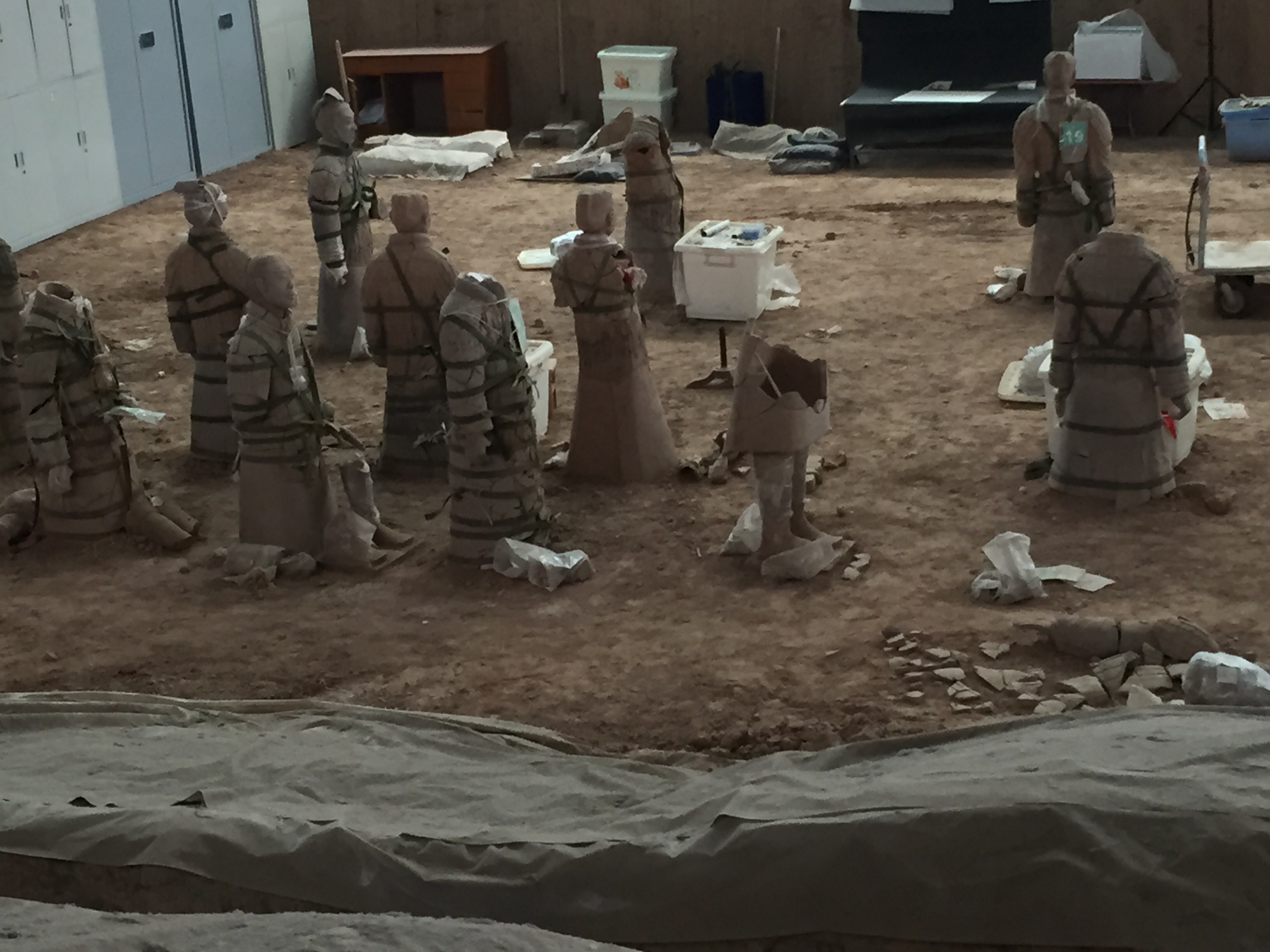
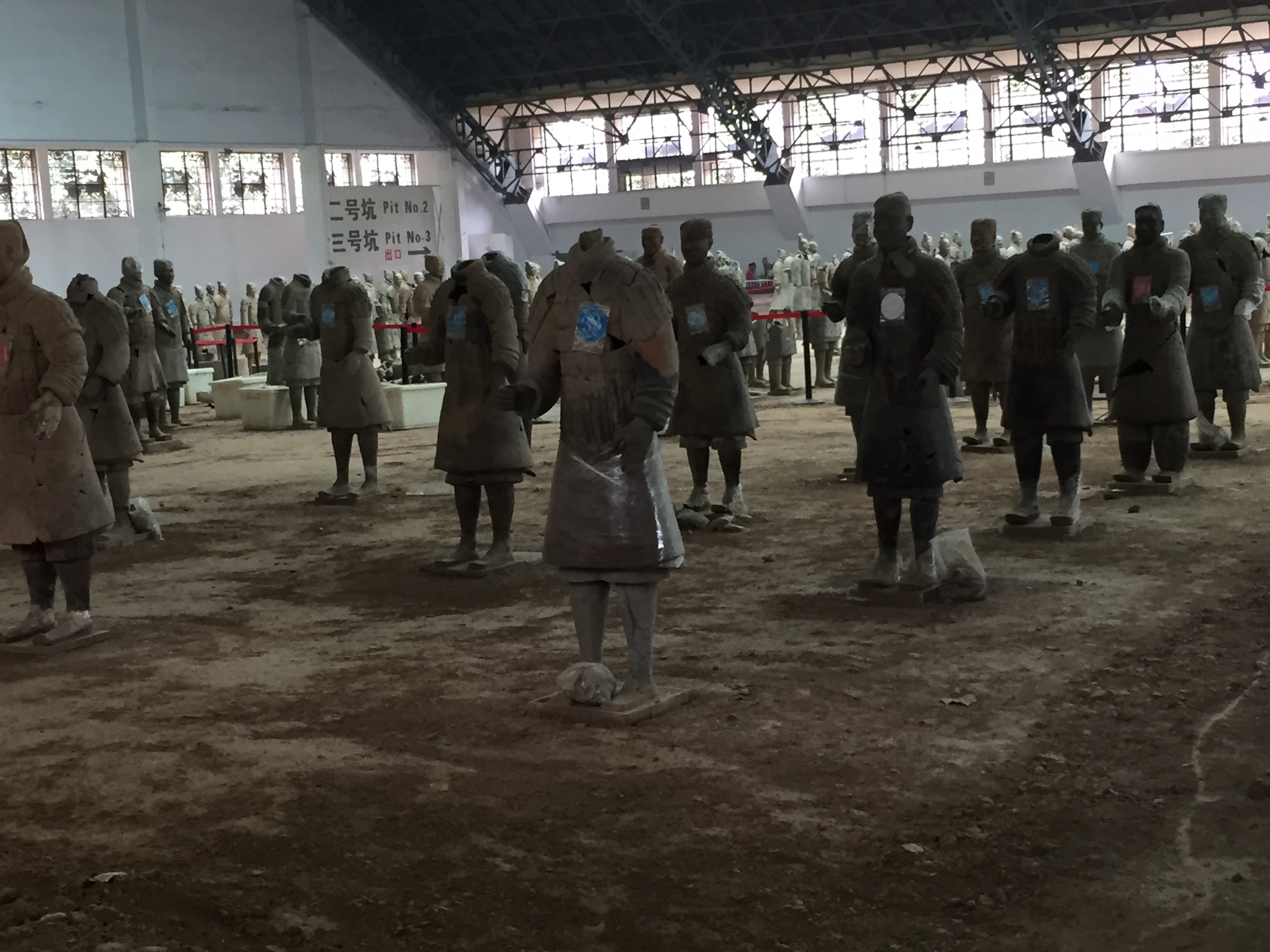
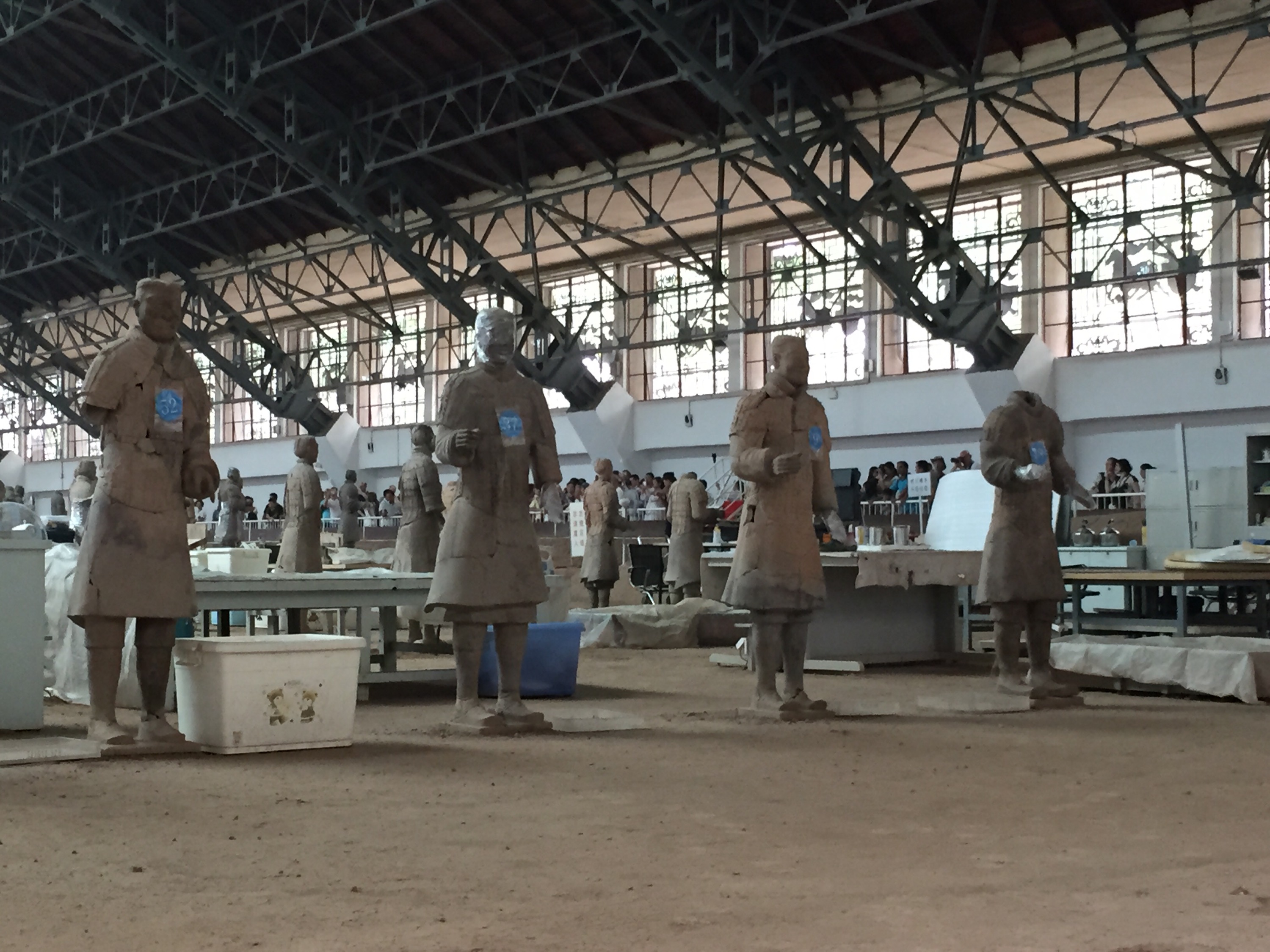 The Emperor’s tomb itself is located about 1.5kms away and has not yet been unearthed. Historical records from the period indicate that that a ‘river and a moat of mercury’ surrounds Qin Shi Huang’s tomb and preliminary testing reveals high level of mercury in the area, which has hampered archeologists efforts to excavate the tomb itself.
The Emperor’s tomb itself is located about 1.5kms away and has not yet been unearthed. Historical records from the period indicate that that a ‘river and a moat of mercury’ surrounds Qin Shi Huang’s tomb and preliminary testing reveals high level of mercury in the area, which has hampered archeologists efforts to excavate the tomb itself.

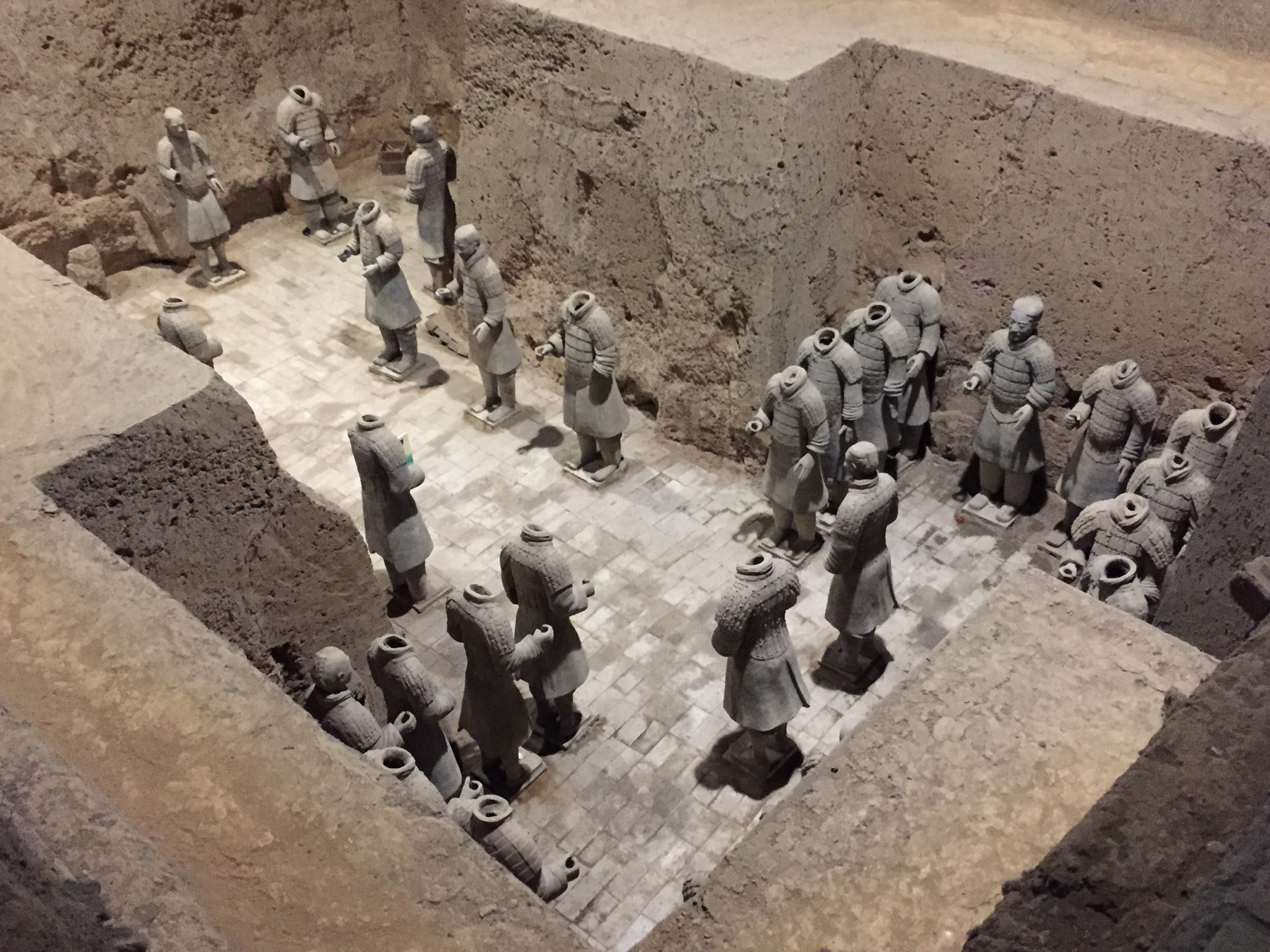
Each individual figure varies in height, rank, uniform, hairstyles (according to rank and occupation). They originally held real weapons such as spears, swords, crossbows, and longbows; they were also painted in bright colours of pink, red, green, blue black, brown, white and purple with a light lacquer finish. They were also supposed to have been modelled on real life soldiers and each figure has unique facial features and clothing – different shoes, belts, buckles, armour. Most of the original weapons were looted over the centuries or have rotten away, and the bulk of the brightly coloured paints have oxidized on exposure to the air and faded away.
 No detail appears to have been left out – even the servants in the stables chambers are dressed as real servants would have been and have all the work and food implements that they would have used in their duties and daily life.
No detail appears to have been left out – even the servants in the stables chambers are dressed as real servants would have been and have all the work and food implements that they would have used in their duties and daily life.

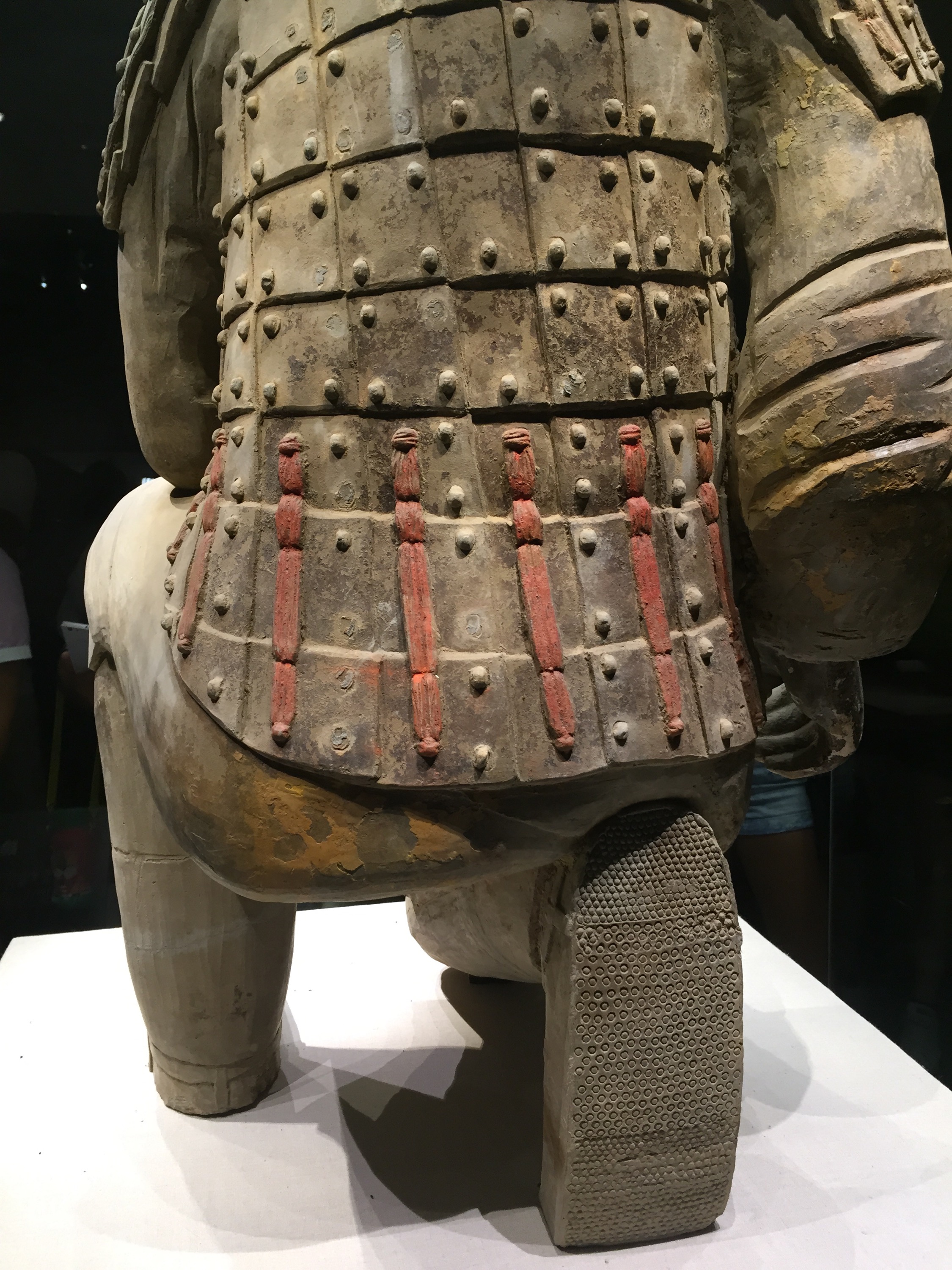
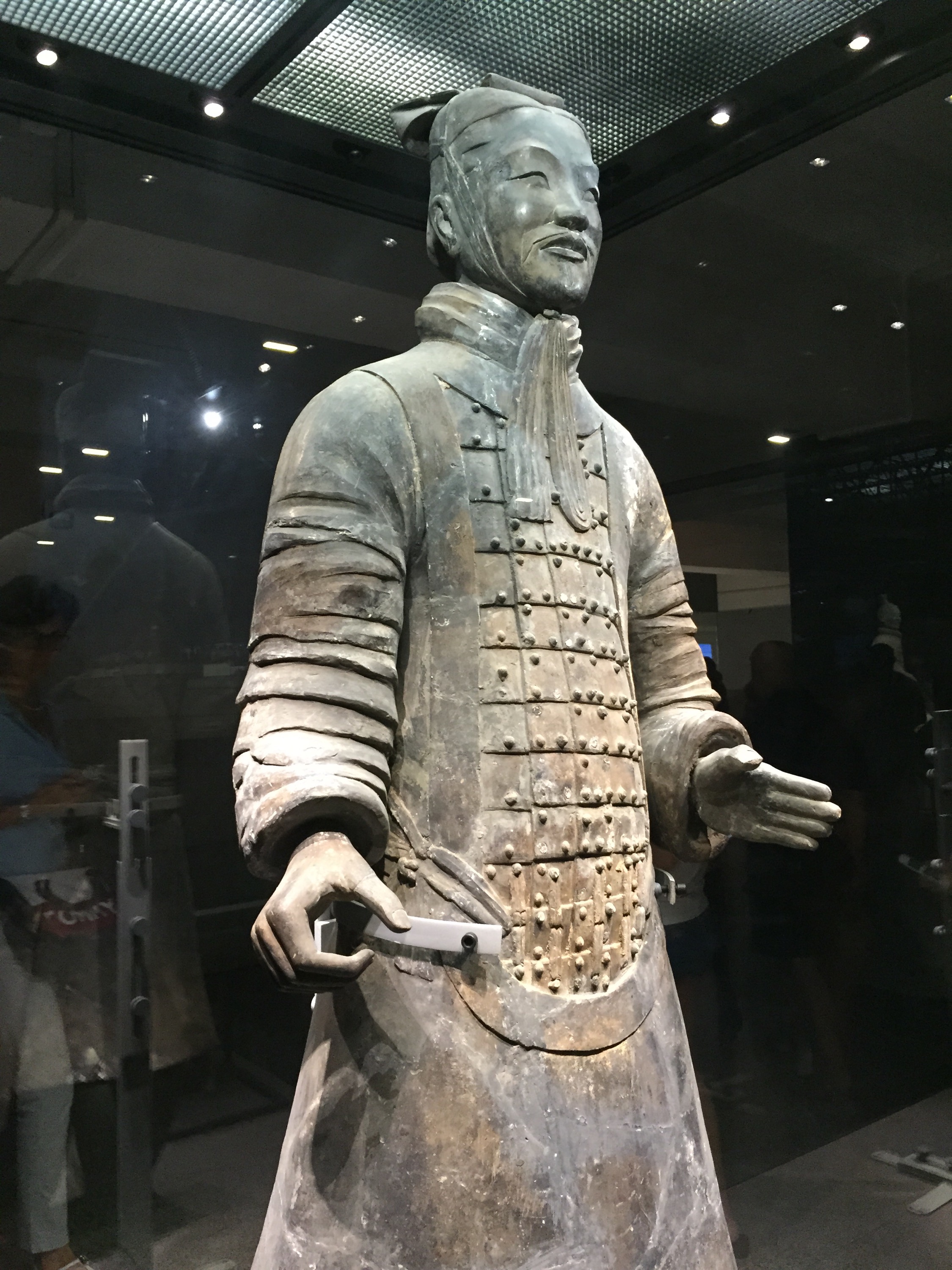

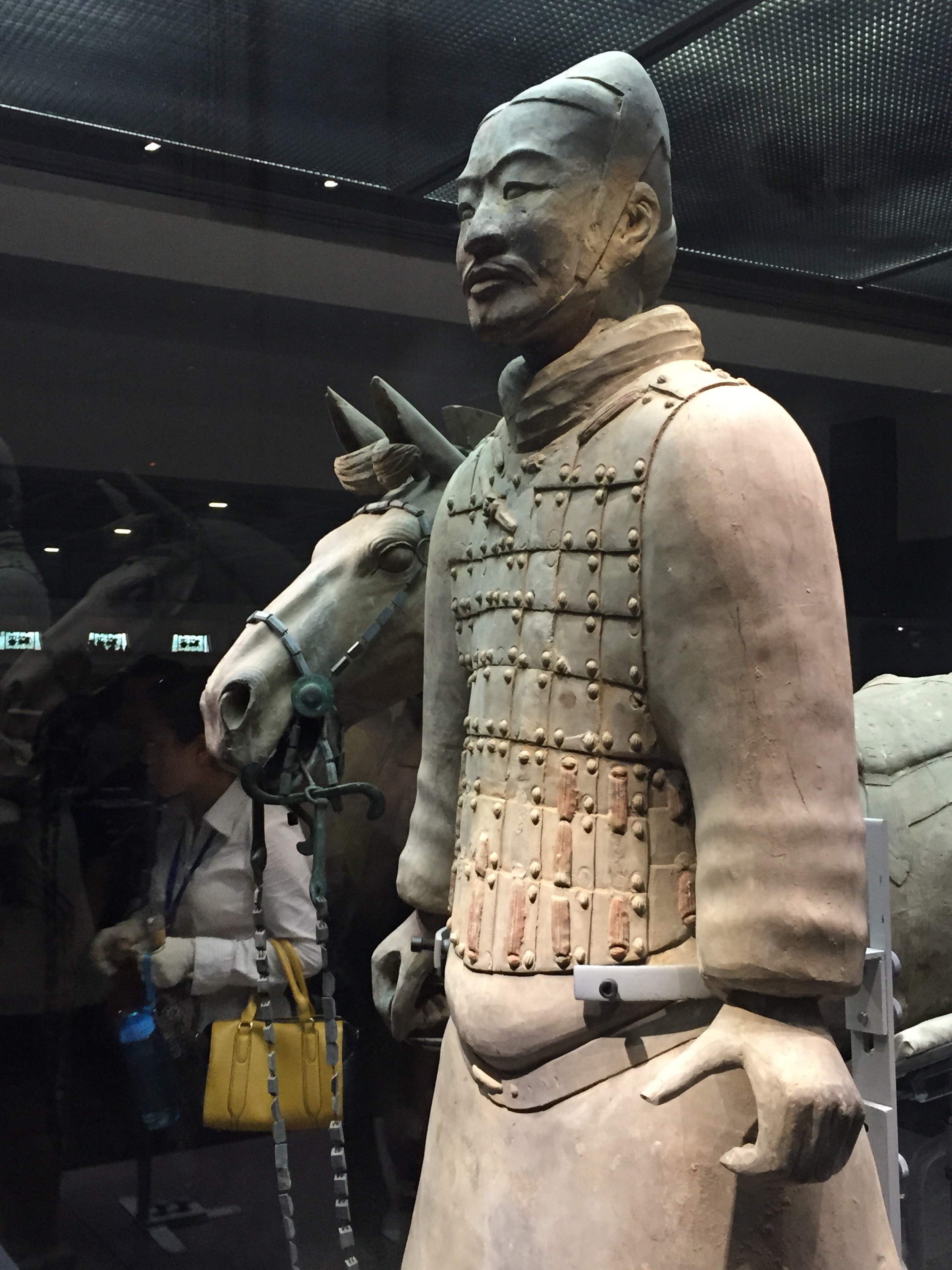

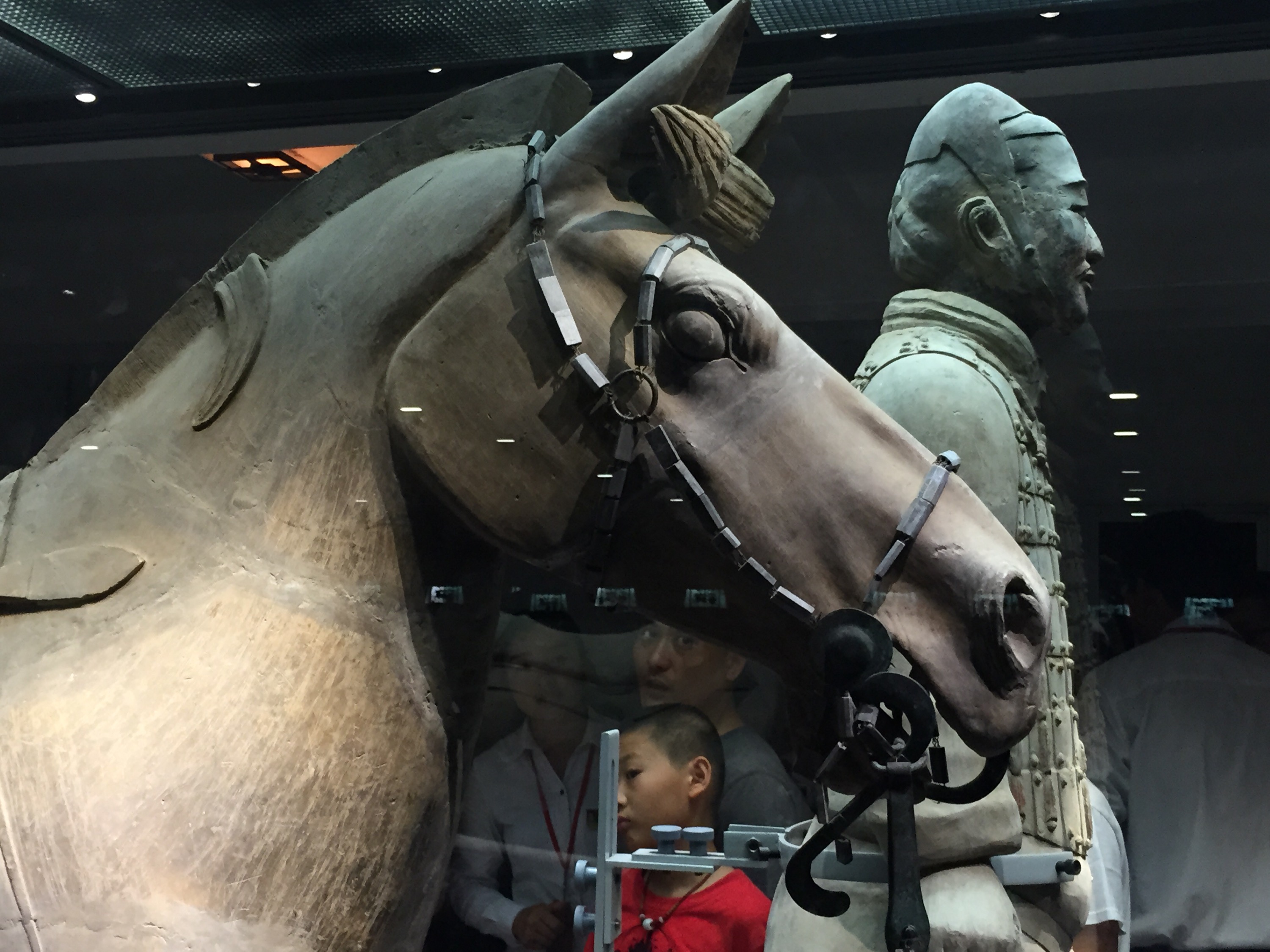


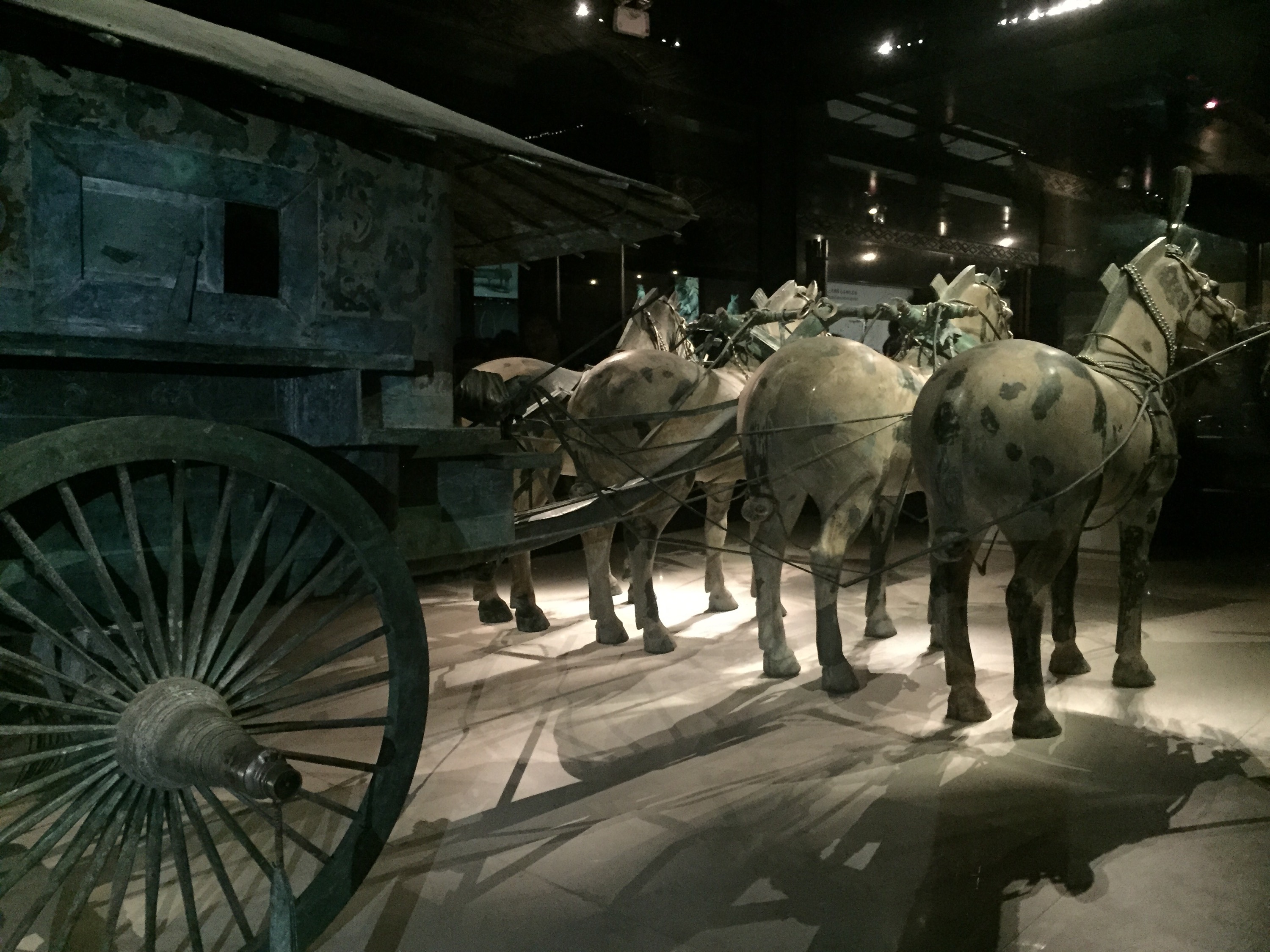 Qin Shi Huang was quite the character apparently – he did many great things for China, created a standardised script called ‘seal script’, he also standardised weights, measurements and distances etc. But he was also a dictatorial tyrant who wanted to control the populace and did so by variously squashing the thinkers of the time – he was known to have buried 460 scholars alive, and burned thousands of ‘unapproved’ books to control ideas and quell the populace.
Qin Shi Huang was quite the character apparently – he did many great things for China, created a standardised script called ‘seal script’, he also standardised weights, measurements and distances etc. But he was also a dictatorial tyrant who wanted to control the populace and did so by variously squashing the thinkers of the time – he was known to have buried 460 scholars alive, and burned thousands of ‘unapproved’ books to control ideas and quell the populace.
 The place is fascinating, but also a complete tourist clusterfuck. We are unfortunately here during peak season, which means that nearly all of the Chinese countryside are on their summer holidays and area touring major historical areas of interest – like the Terracotta Warriors of Xian. To get anywhere near the edges of the pits to take photographs, you literally had to stick your elbows out and barge your way in. When you were finished at the rail, you would edge out in such a way as one of your friends could take your space. The crush of sweaty humanity was distinctly unpleasant, but we are led to believe it is like that for much of the year, the ‘odd season for tourists really only being November and December.
The place is fascinating, but also a complete tourist clusterfuck. We are unfortunately here during peak season, which means that nearly all of the Chinese countryside are on their summer holidays and area touring major historical areas of interest – like the Terracotta Warriors of Xian. To get anywhere near the edges of the pits to take photographs, you literally had to stick your elbows out and barge your way in. When you were finished at the rail, you would edge out in such a way as one of your friends could take your space. The crush of sweaty humanity was distinctly unpleasant, but we are led to believe it is like that for much of the year, the ‘odd season for tourists really only being November and December.
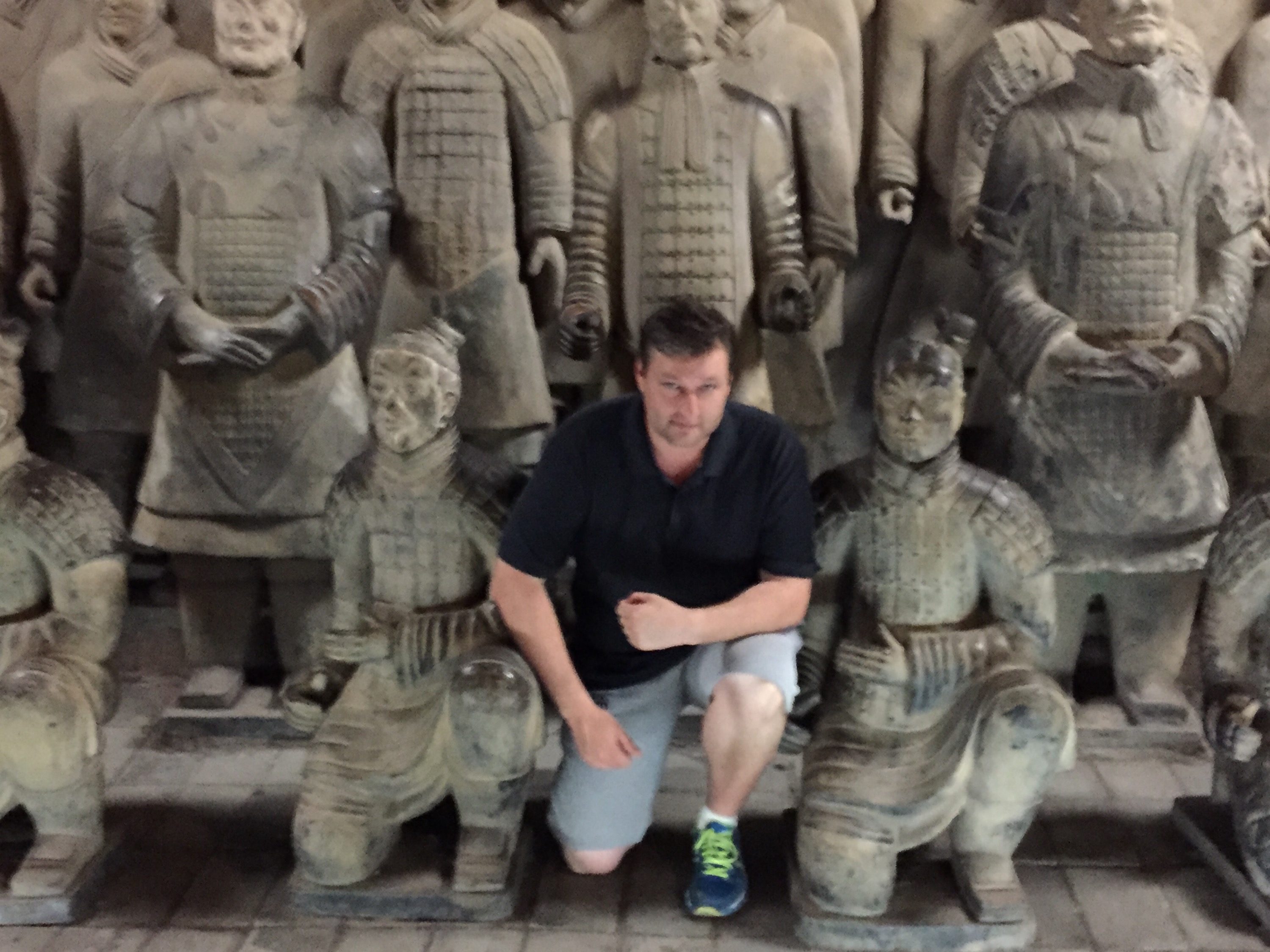 Being short blonde and western, I seem to really cop it in these environments. People who come from rural countryside villages and towns tend to stop and stare, yell at their children to look at the white woman, poke their partners and point at me, or as happened today – some old guy literally pulled my plaited hair while my back was turned. Hard enough to snap my head around. It completely detracts from your enjoyment of an historical and culturally important location when you are busy worrying if you are going to be assaulted. So, as a result, I am loving the places I am seeing in China, but fucking hating the Chinese people and their rude manner, lack of courtesy and different customs that are just gross – hacking up phlegm and spitting in the street, yelling at each other without any care for who is nearby, letting their children run around without pants on in the middle of a museum, allowing them to pee wherever and whenever, smoking in public restroom… all sorts of just undesirable behaviour. So you find yourself spending half your day saying ‘excuse me’ or ‘sorry’ to people who bump into YOU, when you really want to say ‘FUCK OFF AND GET OUT OF MY WAY’.
Being short blonde and western, I seem to really cop it in these environments. People who come from rural countryside villages and towns tend to stop and stare, yell at their children to look at the white woman, poke their partners and point at me, or as happened today – some old guy literally pulled my plaited hair while my back was turned. Hard enough to snap my head around. It completely detracts from your enjoyment of an historical and culturally important location when you are busy worrying if you are going to be assaulted. So, as a result, I am loving the places I am seeing in China, but fucking hating the Chinese people and their rude manner, lack of courtesy and different customs that are just gross – hacking up phlegm and spitting in the street, yelling at each other without any care for who is nearby, letting their children run around without pants on in the middle of a museum, allowing them to pee wherever and whenever, smoking in public restroom… all sorts of just undesirable behaviour. So you find yourself spending half your day saying ‘excuse me’ or ‘sorry’ to people who bump into YOU, when you really want to say ‘FUCK OFF AND GET OUT OF MY WAY’.


After the warrior we went to lunch at a nearby Elegant Hotel – lovely banquet spread again but way too much food. We then had a long drive back to Xian where we went to the Small Goose Pagoda (nothing special, more 14thC crumblies) and the Xian Museum, which would have been marvellous, if only there was a guide or more placards with information in English. Hell I would have settled for Latin or French to be honest. Not hard to whip through 5000 years of history when you can’t hardly read any of the artefact notes.
 Badger seal from 200AD:
Badger seal from 200AD:


 Tang Dynasty Guardians: (that much I did get)
Tang Dynasty Guardians: (that much I did get)




We have a big dumpling dinner and a Tang Dynasty cultural show of music and dance to attend tonight – so I will have to come back and edit this a bit later and report back on what that was like. 🙂
Update:
Well, dumpling dinner was excellent and as per usual, they seem to be bringing us way too much food and not enough beer. 😛 We have some drinkers in our group, so we were constantly harassing the staff for more beer (unfortunately China doesn’t seem to know what cider is *unhappy face*) There were chicken dumplings made to look like little chickens, duck ones that looked like ducks, pork ones that looked like pigs, seafood ones that looked like little fish, and well… you get the idea. Cabbage dumplings, sweet potato, eggplant and all good things as well. One of the girls on our trip was having her birthday the following day so our guide had arranged a suprise birthday cake… it was an interesting cake to say the least. Two think layers of sponge covered and filled with cream, and decoraded with fruit and tomato and parsley. Yeah. Tomato and parsely on a cream covered birthday cake!

The show itself was quite interesting – everything you expect in a Chinese culture show from the Tang Dynasty (expectations schmexpectations!). There was lively dancing, colourful costumes, drumbs, cymbals, instruments I didn’t recognise and singing that sounded like cats mating in an alley way. Absolutely fabulous!















